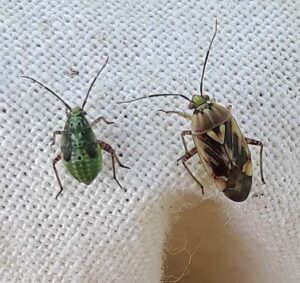Updated lygus threshold of 2-3 per sweep
Key result:
This study validates a new threshold for lygus in canola. The general pattern is that abundances below two lygus per sweep do not reduce yield. Thus, the threshold of two to three lygus per sweep (20-30 per 10 sweeps) is recommended. Because current canola cultivars appear to tolerate lygus damage better than older cultivars, reducing this threshold as prices of canola increase is not recommended.
 Lygus bugs are a sporadic pest of canola at the pod stage. Economic levels of damage are more common in Alberta, specifically from Edmonton to southern Alberta. In the Peace Region, some growers are concerned that lygus pose a risk even at earlier bud and early flower stages. Lygus are sometimes a concern in the Meadow Lake area of Saskatchewan and in southern Manitoba. Outbreaks over wider areas can occur during extreme dry and hot summers, as observed in 2021 throughout Canada.
Lygus bugs are a sporadic pest of canola at the pod stage. Economic levels of damage are more common in Alberta, specifically from Edmonton to southern Alberta. In the Peace Region, some growers are concerned that lygus pose a risk even at earlier bud and early flower stages. Lygus are sometimes a concern in the Meadow Lake area of Saskatchewan and in southern Manitoba. Outbreaks over wider areas can occur during extreme dry and hot summers, as observed in 2021 throughout Canada.
Insecticide spraying during late flower or early pod is becoming a common practice in some regions, but there has been no agreement on economic thresholds and we have limited data for the benefit of spraying at the mid pod stage. The traditional threshold has been one to two lygus per sweep. However, in west central Alberta this threshold is considered too low. In recent years, most fields in this region exceed two lygus per sweep. Therefore, applying the current low threshold would result in excessive, potentially unnecessary insecticide sprays with added costs and detrimental impact on beneficial insects, spiders and pollinators.
Objectives
- Validate lygus economic thresholds in commercial canola fields.
- Determine the impact on lygus from spraying for other pest insects that may reach nominal economic thresholds. (Examples are flea beetles in central/northern areas, and cabbage seedpod weevils in the south.)
- Document landscape features that can influence risk of lygus damage.
Results
Project title, Principal investigator:
“Validation of lygus and other insect pest thresholds in commercial farms throughout the Prairie Provinces,”
Hector Carcamo,
AAFC Lethbridge
Funding:
Alberta Canola, SaskCanola
The main accomplishment is the validation of a new threshold for lygus in canola. Despite large variability at many levels (within a field, between fields and years), the general pattern is that abundances below two lygus per sweep do not reduce yield. In fact, at low abundances (below one per sweep), yields were, on average, higher in fields left unsprayed compared to those sprayed at the late flower/early pod stage. This may result from damage caused by ground spraying at the late flower stage or early pod stage or from indirect impacts of the insecticide on beneficial predators and pollinators. Thus, the threshold derived from a previous cage study of two to three lygus per sweep is recommended. Because current canola cultivars appear to tolerate lygus damage better than older cultivars, reducing this threshold as prices of canola increase is not recommended.
A second important finding is that lygus bugs no longer reach pest status in most regions of the Prairies. It appears that pest risk from lygus occurs mainly in a narrow corridor between Edmonton and Lethbridge and towards the foothills. The main pest species of lygus are Lygus keltoni with L. lineolaris more prevalent in the northern portion of this corridor. Furthermore, in the southern portion of this corridor it appears that new cultivars may be less susceptible to lygus damage than older cultivars. Significant yield losses were not observed in the new study (2016-2019) in contrast to a related study done from 2010-2013 where older hybrid cultivars were planted. The role of shatter resistant cultivars in reducing insect pod damage warrants further study.
Landscape factors affect lygus abundance in southern Alberta. Researchers determined that regions with fewer canola fields could result in higher lygus pest abundance because they concentrate in the fewer fields. This may explain why lygus are less of a problem in the Peace Region. Previous cropping history in a landscape had no effect on lygus abundance, which is not surprising given the high dispersal ability of these bugs.
An important lesson from this research is that studying interactions between pests is a major challenge due to logistics. Finding sites where a given pest will damage a crop is already difficult enough, from a timely research perspective. Finding one where two pests will be high enough that a proper experiment can be executed is even more difficult (even though farmers see this often). Nevertheless, the researchers say it would be of interest to keep track of lygus bugs in fields where flea beetles, seedpod weevils or diamondback moths delay crop maturity.





